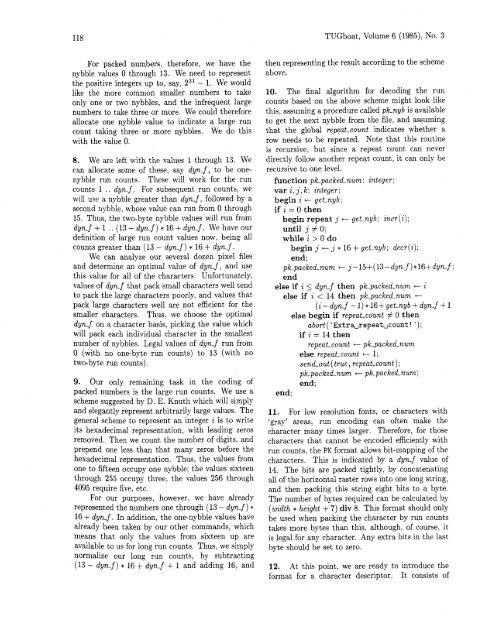(PK) font file format - TUG
(PK) font file format - TUG
(PK) font file format - TUG
You also want an ePaper? Increase the reach of your titles
YUMPU automatically turns print PDFs into web optimized ePapers that Google loves.
118 <strong>TUG</strong>boat, Volume 6 (1985), No. 3<br />
For packed numbers, therefore, we have the<br />
nybble values 0 through 13. We need to represent<br />
the positive integers up to, say, 231 - 1. We would<br />
like the more common smaller numbers to take<br />
only one or two nybbles, and the infrequent large<br />
numbers to take three or more. We could therefore<br />
allocate one nybble value to indicate a large run<br />
count taking three or more nybbles. We do this<br />
with the value 0.<br />
8. We are left with the values 1 through 13. We<br />
can allocate some of these, say dyn-f, to be onenybble<br />
run counts. These will work for the run<br />
counts 1 . . dyn-f. For subsequent run counts, we<br />
will use a nybble greater than dyn-f, followed by a<br />
second nybble, whose value can run from 0 through<br />
15. Thus, the two-byte nybble values will run from<br />
dyn-f + 1 . . (13 - dyn-f) * 16 + dyn-f. We have our<br />
definition of large run count values now, being all<br />
counts greater than (13 - dyn-f) * 16 + dyn-f.<br />
We can analyze our several dozen pixel <strong>file</strong>s<br />
and determine an optimal value of dyn-f, and use<br />
this value for all of the characters. Unfortunately,<br />
values of dyn-f that pack small characters well tend<br />
to pack the large characters poorly, and values that<br />
pack large characters well are not efficient for the<br />
smaller characters. Thus, we choose the optimal<br />
dyn-f on a character basis, picking the value which<br />
will pack each individual character in the smallest<br />
number of nybbles. Legal values of dyn-f run from<br />
0 (with no one-byte run counts) to 13 (with no<br />
two-byte run counts).<br />
9. Our only remaining task in the coding of<br />
packed numbers is the large run counts. We use a<br />
scheme suggested by D. E. Knuth which will simply<br />
and elegantly represent arbitrarily large values. The<br />
general scheme to represent an integer i is to write<br />
its hexadecimal representation, with leading zeros<br />
removed. Then we count the number of digits, and<br />
prepend one less than that many zeros before the<br />
hexadecimal representation. Thus, the values from<br />
one to fifteen occupy one nybble; the values sixteen<br />
through 255 occupy three, the values 256 through<br />
4095 require five, etc.<br />
For our purposes, however, we have already<br />
represented the numbers one through (13 - dyn-f ) *<br />
16 + dyn-f. In addition, the one-nybble values have<br />
already been taken by our other commands, which<br />
means that only the values from sixteen up are<br />
available to us for long run counts. Thus, we simply<br />
normalize our long run counts, by subtracting<br />
(13 - dyn-f) * 16 + dyn-f + 1 and adding 16, and<br />
then representing the result according to the scheme<br />
above.<br />
10. The final algorithm for decoding the run<br />
counts based on the above scheme might look like<br />
this, assuming a procedure called pk-nyb is available<br />
to get the next nybble from the <strong>file</strong>, and assuming<br />
that the global repeat-count indicates whether a<br />
row needs to be repeated. Note that this routine<br />
is recursive, but since a repeat count can never<br />
directly follow another repeat, count, it can only be<br />
recursive to one level.<br />
function pk-packed-num: integer ;<br />
var i, j, k: integer;<br />
begin i c get-nyb;<br />
if i = 0 then<br />
begin repeat j +- get-nyb; incr(i);<br />
until j # 0;<br />
while i > 0 do<br />
begin j +-- j * 16 + get-nyb; decr(i);<br />
end;<br />
pk-packed-num + j-15+(13-dyn-f )*16+dyn-f ;<br />
end<br />
else if i 5 dyn-f then pk-packed-num c i<br />
else if i < 14 then pk-packed-num +-<br />
(i - dyn-f - 1) * 16+ get-nyb + dyn-f + 1<br />
end;<br />
else begin if repeat-count # 0 then<br />
abort ( 'E~trkrepeat~count ! ');<br />
if i = 14 then<br />
repeat-count +- pk-packed-num<br />
else repeat-count t 1;<br />
send-out (true, repeat-count );<br />
pk-packed-num c pk-packed-num;<br />
end;<br />
11. For low resolution <strong>font</strong>s, or characters with<br />
'gray' areas, run encoding can often make the<br />
character many times larger. Therefore, for those<br />
characters that cannot be encoded efficiently with<br />
run counts, the <strong>PK</strong> <strong>format</strong> allows bit-mapping of the<br />
characters. This is indicated by a dyn-f value of<br />
14. The bits are packed tightly, by concatenating<br />
all of the horizontal raster rows into one long string,<br />
and then packing this string eight bits to a byte.<br />
The number of bytes required can be calculated by<br />
(width * height + 7) div 8. This <strong>format</strong> should only<br />
be used when packing the character by run counts<br />
takes more bytes than this, although, of course, it<br />
is legal for any character. Any extra bits in the last<br />
byte should be set to zero.<br />
12. At this point, we are ready to introduce the<br />
<strong>format</strong> for a character descriptor. It consists of

















